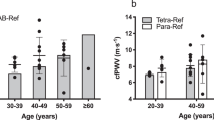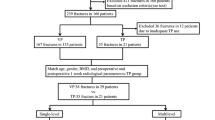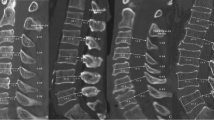Abstract
Anatomical abnormalities of the cervical spine at the level of the Atlas vertebra are associated with relative ischaemia of the brainstem circulation and increased blood pressure (BP). Manual correction of this mal-alignment has been associated with reduced arterial pressure. This pilot study tests the hypothesis that correcting mal-alignment of the Atlas vertebra reduces and maintains a lower BP. Using a double blind, placebo-controlled design at a single center, 50 drug naïve (n=26) or washed out (n=24) patients with Stage 1 hypertension were randomized to receive a National Upper Cervical Chiropractic (NUCCA) procedure or a sham procedure. Patients received no antihypertensive meds during the 8-week study duration. The primary end point was changed in systolic and diastolic BP comparing baseline and week 8, with a 90% power to detect an 8/5 mm Hg difference at week 8 over the placebo group. The study cohort had a mean age 52.7±9.6 years, consisted of 70% males. At week 8, there were differences in systolic BP (−17±9 mm Hg, NUCCA versus −3±11 mm Hg, placebo; P<0.0001) and diastolic BP (−10±11 mm Hg, NUCCA versus −2±7 mm Hg; P=0.002). Lateral displacement of Atlas vertebra (1.0, baseline versus 0.04° week 8, NUCCA versus 0.6, baseline versus 0.5°, placebo; P=0.002). Heart rate was not reduced in the NUCCA group (−0.3 beats per minute, NUCCA, versus 0.5 beats per minute, placebo). No adverse effects were recorded. We conclude that restoration of Atlas alignment is associated with marked and sustained reductions in BP similar to the use of two-drug combination therapy.
This is a preview of subscription content, access via your institution
Access options
Subscribe to this journal
Receive 12 digital issues and online access to articles
$119.00 per year
only $9.92 per issue
Buy this article
- Purchase on Springer Link
- Instant access to full article PDF
Prices may be subject to local taxes which are calculated during checkout

Similar content being viewed by others
References
Chobanian AV, Bakris GL, Black HR, Cushman WC, Green LA, Izzo Jr JL et al. Randomization of patients Seventh report of the joint national committee on prevention, detection, evaluation, and treatment of high blood pressure. Hypertension 2003; 42: 1206–1252.
Hajjar I, Kotchen TA . Trends in prevalence, awareness, treatment, and control of hypertension in the United States, 1988–2000. JAMA 2003; 290: 199–206.
Reis DJ, Morrison S, Ruggiero DA . The C1 area of the brainstem in tonic and reflex control of blood pressure. State of the art lecture. Hypertension 1988; 11: I8–13.
Reis DJ . The brain and hypertension: reflections on 35 years of inquiry into the neurobiology of the circulation. Circulation 1984; 70: III31–III45.
Reis DJ, Nathan MA, Doba N . Two specific brainstem systems which regulate the blood pressure. Clin Exp Pharmacol Physiol 1975; 12 (Suppl 2): 179–183.
Jannetta PJ, Segal R, Wolfson Jr SK . Neurogenic hypertension: etiology and surgical treatment. I. Observations in 53 patients. Ann Surg 1985; 201: 391–398.
Levy EI, Scarrow AM, Jannetta PJ . Microvascular decompression in the treatment of hypertension: review and update. Surg Neurol 2001; 55: 2–10.
Akimura T, Furutani Y, Jimi Y, Saito K, Kashiwagi S, Kato S et al. Essential hypertension and neurovascular compression at the ventrolateral medulla oblongata: MR evaluation. Am J Neuroradiol 1995; 16: 401–405.
Coffee RE, Nicholas JS, Egan BM, Rumboldt Z, D’Agostino S, Patel SJ . Arterial compression of the retro-olivary sulcus of the medulla in essential hypertension: a multivariate analysis. J Hypertens 2005; 23: 2027–2031.
Nicholas JS, D’Agostino SJ, Patel SJ . Arterial compression of the retro-olivary sulcus of the ventrolateral medulla in essential hypertension and diabetes. Hypertension 2005; 46: 982–985.
Bakris G . Combination drug treatment for hypertension with nondiabetic renal disease. Curr Hypertens Rep 2005; 7: 358–359.
Bakris GL, Weir MR . Achieving goal blood pressure in patients with type 2 diabetes: conventional versus fixed-dose combination approaches. J Clin Hypertens 2003; 5: 202–209.
Acknowledgements
This trial was an investigator-initiated study funded by the ATLAS Research Foundation and the NIH K25, HL68139-01A1 who supported Dr Meyer's effort. Additionally, we are grateful to Dr Y Chung who donated his time and expertise in the performance of this trial.
Author information
Authors and Affiliations
Corresponding author
Additional information
Please note that this manuscript is a correction of an original version that was published in advance online (AOP) on 25 January 2007. The changes made were grammatical in nature and have not affected the scientific content of the article.
Rights and permissions
About this article
Cite this article
Bakris, G., Dickholtz, M., Meyer, P. et al. Atlas vertebra realignment and achievement of arterial pressure goal in hypertensive patients: a pilot study. J Hum Hypertens 21, 347–352 (2007). https://doi.org/10.1038/sj.jhh.1002133
Received:
Revised:
Accepted:
Published:
Issue Date:
DOI: https://doi.org/10.1038/sj.jhh.1002133
Keywords
This article is cited by
-
The global summit on the efficacy and effectiveness of spinal manipulative therapy for the prevention and treatment of non-musculoskeletal disorders: a systematic review of the literature
Chiropractic & Manual Therapies (2021)
-
Symptomatic reactions, clinical outcomes and patient satisfaction associated with upper cervical chiropractic care: A prospective, multicenter, cohort study
BMC Musculoskeletal Disorders (2011)
-
Systematic review of clinical trials of cervical manipulation: control group procedures and pain outcomes
Chiropractic & Manual Therapies (2011)
-
Die Manipulation in funktionell ungestörten Regionen des Bewegungssystems
Manuelle Medizin (2011)
-
Effectiveness of manual therapies: the UK evidence report
Chiropractic & Osteopathy (2010)



